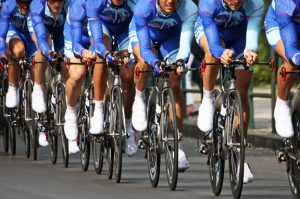
Surgeon Athletes–Lessons from Cycling

How Lessons from Cycling Can Inform Efforts at Continuous Improvement

A recent conversation with an avid cycler helped me draw interesting parallels between how sport and the pursuit of skill so often intersects with our mission to make care better in healthcare. Britain’s national efforts in cycling provide such an interesting case study, taking a program who had never won a single gold medal in its 76 year history to winning seven out of 10 gold medals in two consecutive Olympics and applying the same discipline to lead one of the most successful professional cycling teams ever.
Sir Dave Brailsford, the coach responsible for these efforts, took the principles of the Toyota Production System, also called lean, to infuse the team with the spirit of Kaizen, or continuous improvement. He thought that if the team broke down everything they could think of that went into competing better on a bike, and then improved each element by 1%, then these marginal gains could achieve a significant aggregated increase in performance. This came from everything to the traditional areas of experimenting in wind tunnels for aerodynamic, to applying 5S techniques to the mechanics team truck and painting the floor white to prevent slips from grease, to teaching athletes about proper hand hygiene from a surgeon. This even went as far as requiring all athletes to sleep on team provided mattresses and pillows so athletes could sleep in the same posture with the same support every night. Taken together, they felt that it gave a competitive advantage.
These principles of looking at strategy, human performance, and continuous improvement have the same applications to how surgery is performed. For strategy, so much cognitive effort needs to be spent on understanding patient’s unique attributes, understanding plans for surgery, and involving the team. This can also involve slowing down the machine and working with a multidisciplinary team to understand the approach. With S3P efforts, this include recommending using multidisciplinary indications conferences with anesthesia, medicine, and nursing to fully discuss a patient’s treatment plans.
For human performance, this truly involves a surgeon treating themselves as athletes, caring for their physical conditions and optimizing their movements. But this also involves attention to behavioral psychology and creating an environment for optimum performance. This may involve routines the evening and morning before surgery to cognitively rehearse the procedures but also can include preventing heuristic biases from affecting decision making. At S3P, this involves the development of formal risk stratification scores to formalize the requirements and opportunities for “slowing the machine” and optimizing patients’ modifiable risk factors.
The final aspect of continuous improvement plays heavily into Sir Dave’s efforts at finding marginal gains. The same principles are applied within my own OR. For the past year, we have been using the comprehensive unit-based safety program to work with my operative team to fully map out the steps involved in preparing a patient for surgery to incision. From there, we brainstormed ways to drive more efficiencies. Things included marking with tape the position of the table and posting laminated photos of the way the lights should be set up. While each step would only save several minutes at most, as we found more and more opportunities for efficiencies, this began to increase our time to set up by up to 20%. Today, we are applying this across the entire continuum.
Identifying these principles as critical success factors and ensuring they are in place can allow everyone to focus on improvements and reach an optimal place to improve quality, safety, value, throughput and efficiency.



.png)
.png)
